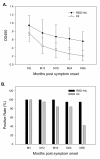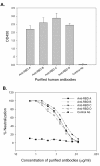Potent and persistent antibody responses against the receptor-binding domain of SARS-CoV spike protein in recovered patients
- PMID: 21047436
- PMCID: PMC2988023
- DOI: 10.1186/1743-422X-7-299
Potent and persistent antibody responses against the receptor-binding domain of SARS-CoV spike protein in recovered patients
Abstract
Background: The spike (S) protein of SARS-CoV not only mediates receptor-binding but also induces neutralizing antibodies. We previously identified the receptor-binding domain (RBD) of S protein as a major target of neutralizing antibodies in animal models and thus proposed a RBD-based vaccine. However, the antigenicity and immunogenicity of RBD in humans need to be characterized.
Results: Two panels of serum samples from recovered SARS patients were included and the antibody responses against the RBD were measured by ELISA and micro-neutralization assays. We found that the RBD of S protein induced potent antibody responses in the recovered SARS patients and RBD-specific antibodies could persist at high titers over three year follow-up. Furthermore, affinity purified anti-RBD antibodies possessed robust neutralizing activity.
Conclusion: The RBD of SARS-CoV is highly immunogenic in humans and mediates protective responses and RBD-based vaccines and diagnostic approaches can be further developed.
Figures



References
-
- Liu S, Xiao G, Chen Y, He Y, Niu J, Escalante CR, Xiong H, Farmar J, Debnath AK, Tien P, Jiang S. Interaction between heptad repeat 1 and 2 regions in spike protein of SARS-associated coronavirus: implications for virus fusogenic mechanism and identification of fusion inhibitors. Lancet. 2004;363:938–947. doi: 10.1016/S0140-6736(04)15788-7. - DOI - PMC - PubMed
-
- Bosch BJ, Martina BE, Van Der Zee R, Lepault J, Haijema BJ, Versluis C, Heck AJ, De Groot R, Osterhaus AD, Rottier PJ. Severe acute respiratory syndrome coronavirus (SARS-CoV) infection inhibition using spike protein heptad repeat-derived peptides. Proc Natl Acad Sci USA. 2004;101:8455–8460. doi: 10.1073/pnas.0400576101. - DOI - PMC - PubMed
Publication types
MeSH terms
Substances
Grants and funding
LinkOut - more resources
Full Text Sources
Other Literature Sources
Miscellaneous

